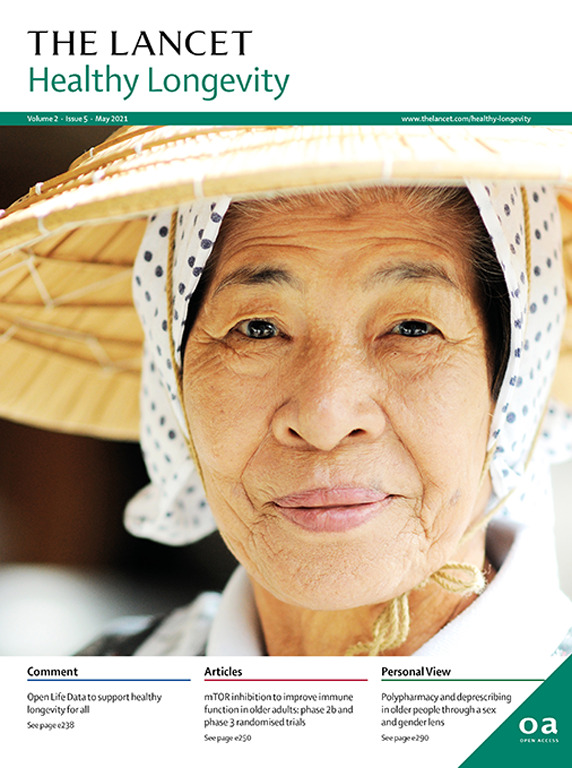Global landscape of COVID-19 vaccination programmes for older adults: a descriptive study
IF 13.4
Q1 GERIATRICS & GERONTOLOGY
引用次数: 0
Abstract
Background
To minimise severe cases and deaths from COVID-19 among high-risk populations such as older adults (aged 60 years and older), it is crucial to monitor and update vaccination strategies. In this study, we aim to provide a global profile of the current COVID-19 vaccination programmes for older adults, including vaccination policies, coverage rates, and vaccine demand.
Methods
We used publicly available data on the COVID-19 vaccines used, vaccination schedules, indicated age groups, and age-specific country-level vaccine coverage, updated through to July 20, 2024. Data on vaccination policy were extracted from publicly available sources in the following priority: (1) official sources (ie, government websites, health department websites, and official reports); (2) resources integrated by institutions or organisations (ie, European Center for Disease Prevention and Control, Africa Center for Disease Prevention and Control, and COVAX); and (3) cross-validated news and media reports derived from government or health department sources. We estimated coverage gaps to achievement of two specific objectives: (1) immunising 100% of older adults with primary series and a booster dose, as per WHO’s goal; and (2) surpassing WHO’s goal by administering one extra booster dose to 80% of older adults or achieving 80% coverage of a 2023–24 series vaccine.
Findings
192 countries reported their use of COVID-19 vaccines for older people, of which 71 vaccine products have been used for older adults and 79 countries have deployed 22 vaccines containing components against variants of concern; 122 countries offered a second booster dose or a special booster dose, while others used only primary series or one booster dose. 96 countries prioritised older people for vaccination. Among countries with available data, the median proportion of individuals completing a primary series was 81% (IQR 58·3–92·0), for a first booster was 53% (14·1–81·7), for a second booster was 44·3% (13·5–69·7), and for a 2023–24 series vaccination was 23·6% (6·6–52·4), with large differences by region. Coverage of the second booster and the 2023–24 series was lower in individuals aged 60–70 years than in older age groups. To achieve the WHO target of 100% coverage for older populations with primary series and a booster dose, 1·01 doses per person are required, and to attain an 80% coverage for a second booster or 2023–24 series, surpassing WHO’s goal, 1·43 doses per person are required.
Interpretation
Progress of COVID-19 vaccination programmes for older adults is uneven across countries, emphasising an ongoing challenge to achieve vaccine equity for this high-risk age group. Therefore, it is essential to establish robust and timely vaccination surveillance systems, especially to facilitate data-driven policies that promote COVID-19 vaccination campaigns worldwide.
Funding
Key Program of the National Natural Science Foundation of China.
全球老年人 COVID-19 疫苗接种计划概况:一项描述性研究。
背景:为了最大限度地减少 COVID-19 在老年人(60 岁及以上)等高风险人群中的重症病例和死亡病例,监测和更新疫苗接种策略至关重要。在本研究中,我们旨在提供当前针对老年人的 COVID-19 疫苗接种计划的全球概况,包括疫苗接种政策、覆盖率和疫苗需求:方法:我们使用了有关所使用的 COVID-19 疫苗、疫苗接种计划、指定年龄组以及特定年龄国家级疫苗接种覆盖率的公开数据,这些数据更新至 2024 年 7 月 20 日。有关疫苗接种政策的数据按以下优先顺序从公开来源中提取:(1) 官方来源(即政府网站、卫生部门网站和官方报告);(2) 机构或组织整合的资源(即欧洲疾病预防控制中心、非洲疾病预防控制中心和 COVAX);(3) 来自政府或卫生部门来源的经过交叉验证的新闻和媒体报道。我们估算了实现以下两个具体目标的覆盖率差距:(1) 按照世卫组织的目标,100% 的老年人接种初级系列疫苗和一剂加强剂;(2) 超过世卫组织的目标,为 80% 的老年人额外接种一剂加强剂,或实现 2023-24 年系列疫苗 80% 的覆盖率:192个国家报告了其对老年人使用COVID-19疫苗的情况,其中71种疫苗产品已用于老年人,79个国家已部署了22种疫苗,其中含有针对令人担忧的变异株的成分;122个国家提供了第二剂加强剂或特殊加强剂,而其他国家仅使用了初级系列疫苗或一剂加强剂。96 个国家优先为老年人接种疫苗。在有数据可查的国家中,完成初级接种的中位数比例为 81%(IQR 58-3-92-0),完成第一次加强接种的中位数比例为 53%(14-1-81-7),完成第二次加强接种的中位数比例为 44-3%(13-5-69-7),完成 2023-24 系列接种的中位数比例为 23-6%(6-6-52-4),各地区之间差异很大。60-70 岁人群的第二次加强接种率和 2023-24 年系列接种率低于年龄较大的人群。要实现世界卫生组织提出的老年人群100%接种初免和加强免疫的目标,每人需要接种1-01剂,而要达到80%的第二次加强免疫或2023-24系列接种覆盖率,超过世界卫生组织的目标,每人需要接种1-43剂:各国老年人 COVID-19 疫苗接种计划的进展并不均衡,这表明要实现这一高风险年龄组的疫苗公平接种仍面临挑战。因此,必须建立健全、及时的疫苗接种监测系统,特别是要促进以数据为导向的政策,在全球范围内推广 COVID-19 疫苗接种活动:国家自然科学基金重点项目。
本文章由计算机程序翻译,如有差异,请以英文原文为准。
求助全文
约1分钟内获得全文
求助全文
来源期刊

Lancet Healthy Longevity
GERIATRICS & GERONTOLOGY-
CiteScore
16.30
自引率
2.30%
发文量
192
审稿时长
12 weeks
期刊介绍:
The Lancet Healthy Longevity, a gold open-access journal, focuses on clinically-relevant longevity and healthy aging research. It covers early-stage clinical research on aging mechanisms, epidemiological studies, and societal research on changing populations. The journal includes clinical trials across disciplines, particularly in gerontology and age-specific clinical guidelines. In line with the Lancet family tradition, it advocates for the rights of all to healthy lives, emphasizing original research likely to impact clinical practice or thinking. Clinical and policy reviews also contribute to shaping the discourse in this rapidly growing discipline.
 求助内容:
求助内容: 应助结果提醒方式:
应助结果提醒方式:


